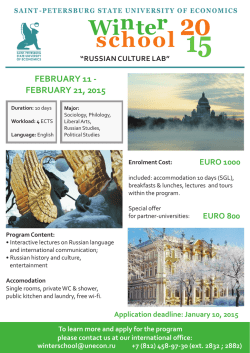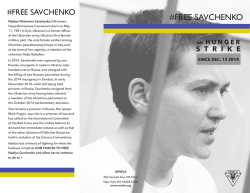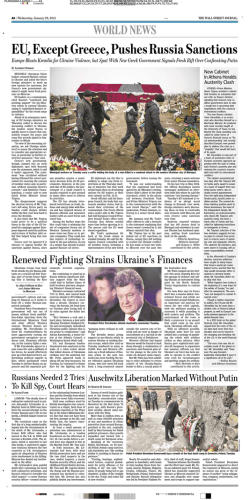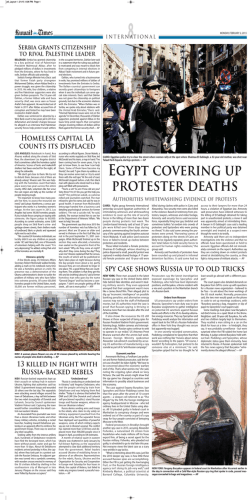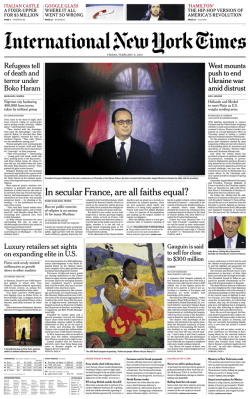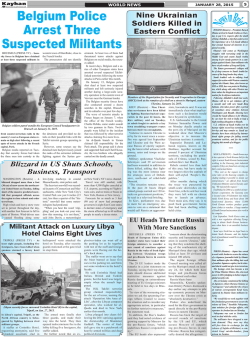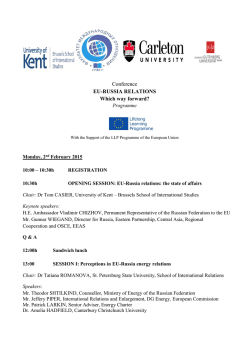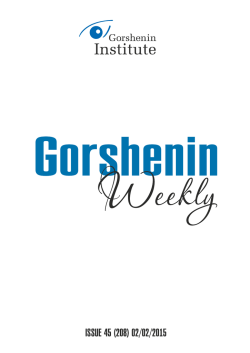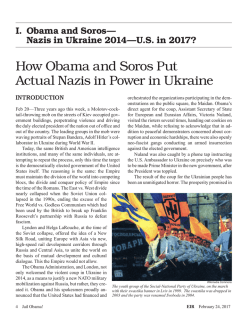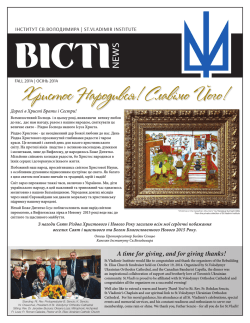
report - Brookings Institution
Preserving Ukraine’s Independence, Resisting Russian Aggression: What the United States and NATO Must Do Ivo Daalder, Michele Flournoy, John Herbst, Jan Lodal, Steven Pifer, James Stavridis, Strobe Talbott and Charles Wald © 2015 The Atlantic Council of the United States. All rights reserved. No part of this publication may be reproduced or transmitted in any form or by any means without permission in writing from the Atlantic Council, except in the case of brief quotations in news articles, critical articles, or reviews. Please direct inquiries to: Atlantic Council 1030 15th Street, NW, 12th Floor Washington, DC 20005 ISBN: 978-1-61977-471-1 Publication design: Krystal Ferguson; Cover photo credit: Reuters/David Mdzinarishvili This report is written and published in accordance with the Atlantic Council Policy on Intellectual Independence. The authors are solely responsible for its analysis and recommendations. The Atlantic Council, the Brookings Institution, and the Chicago Council on Global Affairs, and their funders do not determine, nor do they necessarily endorse or advocate for, any of this report’s conclusions. February 2015 PREFACE This report is the result of collaboration among scholars and former practitioners from the Atlantic Council, the Brookings Institution, the Center for a New American Security, and the Chicago Council on Global Affairs. It is informed by and reflects mid-January discussions with senior NATO and U.S. officials in Brussels and senior Ukrainian civilian and military officials in Kyiv and at the Ukrainian “anti-terror operation” headquarters in Kramatorsk. The report outlines the background to the crisis over Ukraine, describes why the United States and NATO need to engage more actively and urgently, summarizes what the authors heard in discussions at NATO and in Ukraine, and offers specific recommendations for steps that Washington and NATO should take to strengthen Ukraine’s defenses and thereby enhance its ability to deter further Russian aggression. the Donbas provinces of Donetsk and Luhansk. A stronger Ukrainian military, with enhanced defensive capabilities, will increase the prospects for negotiation of a peaceful settlement. When combined with continued robust Western economic sanctions, significant military assistance to bolster Ukraine’s defensive capabilities will make clear that the West will not accept the use of force to change borders in Europe. President Putin may hope to achieve glory through restoring, through intimidation and force, Russian dominion over its neighbors. But a peaceful world requires opposing this through decisive action. We fully endorse the analysis and recommendations contained in the report and urge the Obama Administration and NATO governments, with support from the U.S. Congress and Allied parliaments, to move rapidly to implement the recommendations. Such action would contribute to helping Ukraine restore control over its border and territory in Ivo Daalder, President, the Chicago Council on Global Affairs, and former U.S. Permanent Representative to NATO Michele Flournoy, Chair, Center for a New American Security, and former Under Secretary of Defense John Herbst, Director, Dinu Patriciu Eurasia Center, the Atlantic Council, and former U.S. Ambassador to Ukraine Jan Lodal, Distinguished Fellow and former President, the Atlantic Council, and former Principal Deputy Under Secretary of Defense Steven Pifer, Senior Fellow, the Brookings Institution, and former U.S. Ambassador to Ukraine James Stavridis, Member of the Board, the Atlantic Council, Dean, Fletcher School of Law and Diplomacy, Tufts University, and former Supreme Allied Commander Europe Strobe Talbott, President, the Brookings Institution, and former Deputy Secretary of State Charles Wald, Member of the Board, the Atlantic Council, and former Deputy Commander, U.S. European Command TABLE OF CONTENTS Executive Summary................................................................................................................................................................... 1 Background: A Putin-Manufactured Conflict................................................................................................................. 2 The Case for Increased U.S. Military Assistance Now................................................................................................ 2 Providing Military Support to Deter Further Aggression.......................................................................................... 3 Recommendations for Specific Military Assistance.................................................................................................... 4 Supporting Recommendations............................................................................................................................................ 5 Conclusion.................................................................................................................................................................................... 6 Appendix 1: September 5 Minsk Ceasefire Protocol.................................................................................................... 7 Appendix 2: Russian/Separatist Military Advantages................................................................................................ 8 Appendix 3: Key Elements of the Ukraine Freedom Support Act of 2014......................................................... 9 Appendix 4: Discussions in Brussels, January 12, 2015............................................................................................ 10 Appendix 5: Discussions in Ukraine, January 13-16, 2015..........................................................................................11 Preserving Ukraine’s Independence, Resisting Russian Aggression: What the United States and NATO Must Do EXECUTIVE SUMMARY We face a critical juncture in Ukraine. There is no real ceasefire; indeed, there was a significant increase in fighting along the line of contact in eastern Ukraine in mid-January, with Russian/separatist forces launching attacks on the Donetsk airport and other areas. Instead of a political settlement, Moscow currently seeks to create a frozen conflict in eastern Ukraine as a means to pressure and destabilize the Ukrainian government. Russians continue to be present in the Donetsk and Luhansk oblasts in substantial numbers and have introduced significant amounts of heavy weapons. This could be preparation for another major Russian/ separatist offensive. Russian success would fatally undermine Ukraine’s stability and embolden the Kremlin to further challenge the security order in Europe. It might tempt President Putin to use his doctrine of protecting ethnic Russians and Russian speakers in seeking territorial changes elsewhere in the neighborhood, including in the Baltic States, provoking a direct challenge to NATO. Maintaining Western sanctions are critical but not by themselves sufficient. The West needs to bolster deterrence in Ukraine by raising the risks and costs to Russia of any renewed major offensive. That requires providing direct military assistance—in far larger amounts than provided to date and including lethal defensive arms—so that Ukraine is better able to defend itself. The U.S. government should provide Ukraine $1 billion in military assistance as soon as AT L A N T I C C O U N C I L possible in 2015, followed by additional tranches of $1 billion in FY 2016 and FY 2017. Additional non-lethal assistance should include: counterbattery radars, unmanned aerial vehicles (UAVs), electronic counter-measures for use against opposing UAVs, secure communications capabilities, armored Humvees and medical support equipment. Lethal defensive military assistance should include light anti-armor missiles, given the large numbers of armored vehicles that the Russians have deployed in Donetsk and Luhansk and the abysmal condition of the Ukrainian military’s light anti-armor weapons. Other NATO members should provide military assistance as well. Of particular use to the Ukrainian military would be equipment and weapons from NATO members who operate former Soviet equipment compatible with the arms currently in the Ukrainian inventory. Assisting Ukraine to deter attack and defend itself is not inconsistent with the search for a peaceful, political solution—it is essential to achieving it. Only if the Kremlin knows that the risks and costs of further military action are high will it seek to find an acceptable political solution. Russia’s actions in and against Ukraine pose the gravest threat to European security in more than 30 years. The West has the capacity to stop Russia. The question is whether it has the will. 1 Preserving Ukraine’s Independence, Resisting Russian Aggression: What the United States and NATO Must Do Background: A Putin-Manufactured Conflict Ukrainian President Yanukovych’s November 2013 decision, apparently under great pressure from Putin, not to sign an association agreement with the European Union triggered massive demonstrations and an intense political crisis within Ukraine. The Ukrainian crisis became a major Ukraine-Russia conflict in late February 2014, when Yanukovych abandoned his position and Russian military forces seized Crimea. Just weeks after Russia’s annexation of Crimea, armed separatists—with support, funding and leadership from Moscow—seized government buildings in the eastern Ukrainian oblasts of Donetsk and Luhansk. By May, the Russian-supported separatists had occupied a significant portion of the Donbas. Once a Ukrainian counteroffensive started to make progress in June, Russia began supplying the separatists with heavy weapons, such as tanks, armored personnel carriers, artillery and advanced anti-aircraft systems, apparently including the BUK (NATO designator SA-11/17) surface-to-air missile system that shot down Malaysia Air flight 17 in July. Russia also sent in large numbers of “volunteers.” When Ukrainian forces continued to make progress in August, regular Russian army units entered the Donbas, and attacked and inflicted heavy casualties on the Ukrainian military and Ukrainian volunteer battalions. The Ukrainian military reportedly lost well over half of its deployed armor. A ceasefire was reached in Minsk on September 5, which significantly reduced the number of deaths from the fighting (see Appendix 1 for the twelve points of the ceasefire). But the ceasefire never fully took hold. In some areas, including around the Donetsk airport, fighting continued almost unabated. There was a significant improvement in compliance with the ceasefire beginning on December 8, but shellings across the line of contact between Ukrainian and separatist/ Russian forces in the Donbas increased markedly around January 11, and the situation again deteriorated. Since the ceasefire, the Russian-backed separatists have seized an additional 500 square kilometers of territory. The United States, European Union and other countries imposed increasingly severe economic sanctions on Russia over the course of 2014. They began with sanctions targeted at individuals but in July and September applied much broader and more robust sanctions targeting a range of Russian entities in the financial, energy and defense sectors. Sanctions appear to be having a significant impact on the Russian 2 economy—particularly as oil prices have dropped substantially, sharply reducing export earnings. But they have not yet achieved their principal political goal: effecting a change in Russian policy toward Ukraine. Western leaders have stated that sanctions will remain in place until the Kremlin’s policy changes in a significant way. Although there have been numerous diplomatic exchanges since the September 5 ceasefire agreement, little real progress has been made toward a broader settlement. The Russians have done little to implement the ceasefire terms. They have not withdrawn their forces and equipment; indeed, NATO and Ukrainian sources report a significant influx of Russian heavy equipment in December and January. By all appearances, as of mid-January, the Russian government does not seek a genuine settlement in eastern Ukraine but intends to create a frozen conflict as a means to pressure and destabilize the Ukrainian government. Russian and separatist forces currently operating in eastern Ukraine enjoy significant advantages over the Ukrainian armed forces in air superiority, intelligence, electronic warfare, command and control, artillery and rockets, supply and logistics, and sanctuary in Russia (see Appendix 2 for more detail). These advantages have significantly contributed to losses suffered by Ukrainian forces since the September 5 ceasefire. These capabilities most likely render Ukrainian forces unable to prevent, and unlikely to halt on favorable terms, a major offensive by Russian and separatist forces to take additional territory in the Donetsk and Luhansk oblasts or to create a land bridge through Mariupol to Crimea. The Case for Increased U.S. Military Assistance Now The situation in eastern Ukraine is urgent and deteriorating. In recent weeks, the flow of heavy weapons has grown markedly, and Moscow is no longer taking steps to hide this support from overhead imagery. Fighting along the line of contact increased significantly during the week of January 19. Aleksandr Zakharchenko, leader of the self-proclaimed “Donetsk People’s Republic,” indicated on January 23 that the separatists would seek to take all of the Donetsk oblast. Large numbers of Russian forces remain deployed along the border, ready to enter Ukraine on very short notice. Russian and separatist forces clearly have the capacity for further offensive military action—whether to gain control of the entire Donbas region or, worse, to AT L A N T I C C O U N C I L Preserving Ukraine’s Independence, Resisting Russian Aggression: What the United States and NATO Must Do establish a land bridge between Russia and the Crimea through effective control of southeastern Ukraine. Any such offensive move would set back the prospect for a peaceful settlement and further destabilize Ukraine. The costs to the West of maintaining an independent Ukraine would then only grow, and Moscow might be emboldened to take further actions. While these actions may not seem likely, they certainly are not unthinkable. Few analysts at the end of 2013 would have considered a Russian military seizure of Crimea or invasion of the Donbas “thinkable.” The post-World War II effort to create a safer Europe is under serious threat. The 1975 Conference on Security and Cooperation in Europe Final Act, in which Russia agreed to respect the “inviolability of borders” in Europe, has been blatantly violated. The United States, moreover, is a signatory to the 1994 Budapest Memorandum on Security Assurances for Ukraine. In that document, the United States, Britain and Russia committed to respect Ukraine’s sovereignty, independence and territorial integrity, and not to use or threaten to use force against Ukraine. Russia has grossly violated those commitments, which were key to Kyiv’s decision to eliminate its nuclear weapons. The United States and Britain should, in response, do more to robustly support Ukraine and penalize Russia. This is not just a question of honoring U.S. commitments under international agreements. It is important for preserving the credibility of security assurances for the future, when they might play a role in resolving other nuclear proliferation cases, such as Iran and North Korea. Above and beyond Ukraine—and more important in strategic terms for the United States and NATO—is the need to respond to the challenge to European and Eurasian security posed by the Kremlin’s aggressive policies. Russia has broken the cardinal rule of postwar European security, i.e., states must not use military force to change international borders. Putin and the Kremlin have proclaimed a unique and legally dubious right to “protect” ethnic Russians and Russian speakers, wherever they are located and whatever their citizenship. This was the justification that Putin belatedly offered for Russia’s illegal annexation of Crimea, despite the fact that there was no credible threat to ethnic Russians in Crimea. If not constrained, such Russian policies represent a clear danger to European security, the North Atlantic community, as well as to Russia’s neighbors in Eurasia. Given the many other world challenges confronting the United States, especially problems in the broader Middle AT L A N T I C C O U N C I L East and the strategic challenge posed by the rise of China, Washington and other capitals have not devoted sufficient attention to the threat posed by Russia and its implications for Western security. This must change. If the United States and NATO do not adequately support Ukraine, Moscow may well conclude that the kinds of tactics it has employed over the past year can be applied elsewhere. Of particular concern would be Russian actions to destabilize Estonia or Latvia, each of which has a significant ethnic Russian minority and both of which are NATO members to whom the United States and allies have an Article 5 commitment. The Kremlin has already demonstrated aggressive intent in the Baltics by kidnapping an Estonian security official the day the NATO Wales summit ended. To be sure, there are issues on which the interests of the United States and the West, on the one hand, and Russia, on the other, coincide. These include preventing Iran from acquiring nuclear arms, avoiding a return of the Taliban or chaos in Afghanistan, the broader counterterrorism struggle, and controlling nuclear weapons and materials. But these interests should not outweigh the West’s interest in blocking Russian aggression that poses a threat not just to Ukraine, but also to the security of broader Europe and the transatlantic community. The world has faced this kind of challenge before. History makes clear that the only way to stop such aggression from precipitating a regional or even worldwide conflagration is to deter and defend against it as early as possible and not to be fooled by protestations of innocent motives or lack of further ambitions. Providing Military Support to Deter Further Aggression The Ukrainian military appears capable of limited military operations, such as the January 19 counterattack on the Donetsk airport (the airport reportedly has since been lost). Given the experience of August, however, Kyiv is most unlikely to launch a major military effort to try to regain control of Donetsk and Luhansk; President Poroshenko has said there can be no military solution and has sought a negotiated settlement. There remains, however, the question of Kyiv’s ability to defend itself against further Russian attacks. Even with enormous support from the West, the Ukrainian army will not be able to defeat a determined attack by the Russian military. This point is well understood in 3 Preserving Ukraine’s Independence, Resisting Russian Aggression: What the United States and NATO Must Do Kyiv. The more appropriate goal of Western military assistance should be to give the Ukrainian military additional defense capabilities that would allow it to inflict significant costs on the Russian military, should the Russians launch new offensive operations, sufficient enough that Moscow will be deterred from further aggression. The United States and NATO should seek to create a situation in which the Kremlin considers the option of further military action in or against Ukraine too costly to pursue. The combination of closing off that option plus the cumulative impact of Western economic sanctions could produce conditions in which Moscow decides to negotiate a genuine settlement that allows Ukraine to reestablish full sovereignty over Donetsk and Luhansk. (The West cannot lose sight of the status of Crimea, though Kyiv has said that that is an issue for the longer term; it correctly attaches priority to the Donbas situation.) Putin’s aggression in Ukraine and self-proclaimed right to protect ethnic Russians and Russian speakers wherever they are pose the gravest security threat to the transatlantic community and Eurasia since the end of the Cold War. The United States and NATO must recognize this danger and adjust policies and allocate resources accordingly. A firm Western response can bolster Kyiv’s ability to deter further Russian attacks. Moreover, if confronted by a strong Western response in support of Ukraine, the Kremlin will be far less tempted to challenge the security or territorial integrity of other states, including NATO members Estonia and Latvia. Recommendations for Specific Military Assistance Bolstering Ukraine’s defense capabilities will require a commitment of serious resources. The U.S. government in 2014 pledged $120 million in non-lethal military assistance, of which about half has been delivered. The Ukraine Freedom Support Act of 2014 authorized—but did not appropriate—$350 million in military assistance (non-lethal and lethal) over three years (see Appendix 3 for key provisions of the Act). This is a beginning. But a much more substantial effort is required. The administration should request, and Congress should immediately authorize and appropriate, $1 billion in assistance to bolster Kyiv’s defense and deterrence capabilities as rapidly as possible in 2015, with additional tranches of $1 billion to be provided in FY 2016 and FY 2017. Congressional staff should coordinate with the Departments of Defense and State 4 to ensure that Congressional authorizations are written in a way that allows the government to make quick and efficient use of the assistance. Some of us traveled January 12-16 to Brussels for discussions with senior NATO leaders, to Kyiv for discussions with senior Ukrainian civilian and military leaders, and to Kramatorsk to meet with the commanding general of the “anti-terror operation” and his staff.1 According to both NATO and Ukrainian officials, Russian military personnel are in the Donbas, and there has been a significant influx of additional Russian heavy equipment in December and January. The Ukrainians reported that the Russians make heavy use of unmanned aerial vehicles (UAVs) for surveillance and reconnaissance and combine those with long-range artillery and rocket strikes with devastating effect. (See Appendices 4 and 5 for details on discussions in Brussels and Ukraine.) The following recommendations, based on what we heard in Brussels, Kyiv and Kramatorsk, constitute a minimum immediate response. Washington should urgently consult with Kyiv on provision of the following types of military assistance, with a view to rapid procurement—or provision from existing U.S. defense stocks—and delivery: • Counter-battery radars that can detect and locate the origin of multiple launch rocket system (MLRS) launches and artillery firings out to a range of 30-40 kilometers. These will enable the Ukrainian military to identify ceasefire violations and potentially to target the Russian/separatist weapons that have thus far caused the greatest number of Ukrainian casualties. (Approximately 70 percent of Ukrainian casualties are from rocket and artillery fire.) • Medium altitude/medium range UAVs. These will assist the Ukrainian military to increase its tactical situational awareness, identify opposing troop deployments, and locate opposing MLRS and artillery. • Electronic counter-measures for use against opposing UAVs. This will give the Ukrainian military capabilities to disrupt opposition UAVs conducting missions against Ukrainian forces. • Secure communications capabilities. Much Ukrainian tactical communication currently is conducted over non-secure radios or cell phones and thus is extremely vulnerable to interception by Russian intelligencegathering systems. 1 Daalder, Herbst, Lodal, Pifer and Wald traveled to Brussels and Ukraine. AT L A N T I C C O U N C I L Preserving Ukraine’s Independence, Resisting Russian Aggression: What the United States and NATO Must Do • Armored Humvees. With Russian UAVs patrolling the skies and the persistent threat of Russian precision rocket and artillery fire, Ukrainian forces require all-weather mobility, speed, reliability and a measure of protection as they move between positions on the battlefield. to provide equipment and weapons from their stocks to Ukraine. For the longer term, U.S. military experts should consult with the Ukrainian military on steps to build a stronger national air defense. As part of this discussion, the United States should not rule out the possibility of helping provide advanced air defense systems. • In addition to the above non-lethal items, the U.S. government should immediately change its policy from prohibiting lethal assistance to allowing provision of defensive military assistance, which may include lethal assistance, most importantly, light antiarmor missiles. Ukrainian light anti-armor capabilities are severely lacking at a time when the Russians have moved large numbers of tanks and armored personnel carriers into the Donbas (70 percent of their existing stocks of light anti-armor weapons reportedly do not work). Any major Russian/separatist advance beyond the line of contact would presumably make heavy use of tanks and armored personnel carriers. Anti-armor missiles would give the Ukrainian army the capability to impose heavier costs and support the disruption of such attacks. Raising the risks and costs will help deter further Russian offensive operations. Some in the West are concerned that provision of military assistance, particularly of lethal arms, would cause Russia to escalate the crisis. We vehemently disagree. Russia has already continuously escalated: seizing and annexing Crimea, encouraging and aiding separatists in eastern Ukraine, providing the separatists with heavy arms, and ultimately invading the Donbas with regular Russian army units. Although NATO and Ukraine differ over whether Russian regular units have been withdrawn, there is no dispute that a significant number of Russian officers and a large amount of Russian military equipment remain in the Donbas. Enhanced military assistance would increase Kyiv’s capability to deter further Russian escalation. • Medical support equipment. Ukrainian casualties are greater because of their relatively underdeveloped and severely under resourced military medical system. The provision of field hospitals would greatly improve their soldiers’ survival rate. Given the urgency of the situation—some fear that a new offensive could be launched once the spring arrives in April/May—consideration should be given to drawing equipment from U.S. stocks and using assistance funds to replenish U.S. inventories. Bolstering Ukraine’s defenses should not be a U.S.-only responsibility. NATO members should also increase their military assistance to Ukraine, with a view to meeting the priority needs identified above. NATO allies who have former Soviet/Warsaw Pact equipment and weapons systems similar to or compatible with those now operated by the Ukrainian military should consider contributing those to Kyiv’s defense capabilities. Ukraine has a significant need for improved air defenses. While Russian resort to large-scale air strikes would remove any veneer from Moscow’s claim that its military is not engaged in operations in/against Ukraine, such action cannot be excluded. Procuring advanced U.S. air defense weapons would be expensive, and integrating them into the existing Ukrainian air defense system would take time. A quicker solution would be for NATO members who operate similar former Soviet air defenses AT L A N T I C C O U N C I L The U.S. government should approach Poland, the Baltic States, Canada and Britain regarding their readiness to provide lethal military assistance. Such assistance should be coordinated to avoid duplication of efforts. Poland, in particular, as a former Warsaw Pact member, should be able to help with consumables and spare parts, as well as compatible equipment, since the bulk of Ukraine’s equipment is Soviet in origin. Supporting Recommendations There exists a clear gap between NATO and Ukrainian intelligence estimates with regard to the number and organization of Russian military personnel in eastern Ukraine. NATO and Ukrainian intelligence analysts should consult with a view to developing a common picture of the Russian presence. It appears that there are significant gaps in U.S. and NATO intelligence on Russian activities in and near eastern Ukraine. Given the grave nature of the danger posed by the Kremlin’s aggression in Ukraine, the United States and NATO should increase intelligence coverage of the relatively small Ukrainian area of operations. Closing this intelligence gap requires an immediate shift of more intelligence assets to the Ukraine/Russia theater. U.S. military equipment should be provided to the Ukrainian army only, not to the Ukrainian volunteer battalions. The U.S. Defense Attaché Office in Kyiv should be tasked to monitor the equipment’s employment in order to ensure its effective and appropriate use. 5 Preserving Ukraine’s Independence, Resisting Russian Aggression: What the United States and NATO Must Do As a condition of this assistance, the U.S. government should require the Ukrainian government to develop and implement a plan to integrate the volunteer battalions into—and place them under command of—regular army units and the National Guard as rapidly as possible. That would enhance the effectiveness of Ukrainian military operations. In providing military equipment, the United States and its NATO partners should steer clear of equipment that is of such technological sophistication that it would require U.S. or NATO personnel to operate or maintain. Ukraine’s defense and deterrence posture can be bolstered without a direct U.S. or NATO presence on the ground, and we would not support such a presence under current circumstances. Conclusion The West should work with Ukraine to create a successful and prosperous democratic state that is capable of choosing its own foreign policy course. The Ukrainian government has stated that it will institute economic and political reforms, as well as institute anti-corruption measures. Ukraine will need more financial support from international financial institutions, such as the International Monetary Fund, and the West. Others have made recommendations for such additional support, provided that Ukraine does indeed move forward on reform. Success in deterring 6 and, if necessary, defending against further aggression will strengthen Ukraine’s sovereignty, but that may matter little unless the Ukrainian government moves forward with serious reforms. The robust political and economic sanctions currently imposed on Russia with the full support of our European allies, and with the strong leadership of German Chancellor Merkel, are having an impact on the Russian economy and appear to have taken the Russian leadership by surprise. If Kyiv can deter further Russian military aggression while the sanctions have further impact on the Russian economy, there is a chance that Moscow will alter its course and seek a peaceful settlement in eastern Ukraine. In the meantime, however, Ukraine finds itself in a perilous state, and the Kremlin’s aggression presents the transatlantic community with its most serious security threat in more than 30 years. The United States and NATO must respond, both to support Ukraine and to push back against Russia’s unacceptable challenge to the post-war European security order. This will require more military assistance, some of it lethal but none of it offensive. Should we delay action, the West should expect that the price will only grow. Should we not act more robustly, we can expect to face further Russian incursions, possibly including attempts to redraw borders elsewhere, and efforts to intimidate former Soviet states into accepting Russian dominance. AT L A N T I C C O U N C I L Preserving Ukraine’s Independence, Resisting Russian Aggression: What the United States and NATO Must Do APPENDIX 1: September 5 Minsk Ceasefire Protocol Following is an informal translation of the Russian language text of the ceasefire protocol signed on September 5, 2014: Protocol on the results of the consultations of the trilateral contact group regarding joint steps towards implementation of the peace plan of President of Ukraine Petro Poroshenko and the initiatives of President of Russia Vladimir Putin As a result of consideration and discussion of the proposals by members of the consultations in Minsk on September 1, 2014, the trilateral contact group composed of representatives from Ukraine, the Russian Federation and the Organization for Security and Cooperation in Europe, an understanding was reached regarding the need to take the following steps: 1. Provide for an immediate and bilateral ceasefire. 2. Provide OSCE monitoring and verification of the ceasefire. 10.Remove illegal military formations, military equipment, and militants and mercenaries from the territory of Ukraine. 11.Approve a program for economic development of the Donbas and renew the vital functions of the region. 12.Give guarantees of personal security for participants in the consultations. Members of the trilateral contact group: Ambassador Heidi Tagliavini (Signed) Second President of Ukraine L. D. Kuchma (Signed) Ambassador of Russian Federation to Ukraine M. Yu. Zurabov (Signed) A. V. Zakharchenko (Signed) I. V. Plotnitskiy (Signed) 3. Conduct decentralization of power, including through approval of the law of Ukraine “On the temporary order of local self-government in certain districts of the Donetsk and Luhansk oblasts” (the law on special status). 4. Provide permanent monitoring at the UkrainianRussian state border, and verification by OSCE, with creation of a safety zone in the areas adjacent to the border in Ukraine and the Russian Federation. 6. Approve a law to prevent the persecution and punishment of persons in regard to events that took place in certain districts of the Donetsk and Luhansk regions of Ukraine. 9. Conduct early local elections in accordance with the law of Ukraine “On the temporary order of local self-government in certain districts of the Donetsk and Luhansk oblasts” (law on special status). 5. Immediately free all hostages and persons being held illegally. 7. Continue an inclusive national dialogue. 8. Take measures to improve the humanitarian situation in Donbas. AT L A N T I C C O U N C I L 7 Preserving Ukraine’s Independence, Resisting Russian Aggression: What the United States and NATO Must Do APPENDIX 2: Russian/Separatist Military Advantages Russian and separatist forces enjoy significant military advantages over the Ukrainian armed forces, including the following: • Air superiority: Russian/separatist forces have denied Ukrainian forces the ability to attack, collect intelligence, maneuver and resupply their forces in Ukraine’s sovereign airspace. Ukrainian forces have halted all flight operations in eastern Ukraine due to effective Russian/separatist employment of shoulder-fired man-portable air defense systems (MANPADS), which have downed numerous Ukrainian fixed and rotary-wing aircraft, and advanced radarguided surface-to-air missiles, such as the BUK (NATO designator SA-11/17) which is widely believed to have downed Malaysia Air 17 in July 2014. • Intelligence, surveillance and reconnaissance: Russian/separatist forces employ unmanned aerial vehicles, including the Aesop 100 and 4-post, to overfly Ukrainian forces, often coinciding with artillery and rocket attacks, likely collecting video/ imagery intelligence to aid targeting and to assess attack effectiveness as well as collecting signals intelligence to monitor the mostly unencrypted Ukrainian communications. • Electronic warfare: Russian/separatist forces employ advanced systems to jam communications and GPS signals, disrupting Ukrainian C2, maneuver of forces, air operations and targeting. • Artillery and rockets: Russian/separatist forces employ long-range artillery and multiple launch rocket systems such as the GRAD, with capacity to put large amounts of munitions into a target area at ranges up to 30-40 kilometers. • Supply and logistics: Russian/separatist forces receive supplies from Russia into the Donetsk and Luhansk oblasts through the unsecured UkraineRussia border. • Sanctuary: Russia provides advisors, training, weapons, equipment and safe haven for separatists and their Russian partners bound for operations inside Ukraine. Ukrainian forces are prohibited from attacking targets in Russia. • Command and control (C2): Russian/separatist forces use secure/encrypted communications systems and their own cell phone network, while Ukrainian forces lack signals intelligence collection or jamming systems to collect or disrupt these capabilities. 8 AT L A N T I C C O U N C I L Preserving Ukraine’s Independence, Resisting Russian Aggression: What the United States and NATO Must Do APPENDIX 3: Key Elements of the Ukraine Freedom Support Act of 2014 Statement of Policy (Section 3): “It is the policy of the United States to further assist the Government of Ukraine in restoring its sovereignty and territorial integrity to deter the Government of the Russian Federation from further destabilizing and invading Ukraine and other independent countries.” Increased Military Assistance for the Government of Ukraine (Section 6): “The President is authorized to provide defense articles, defense services, and training to the Government of Ukraine for the purpose of countering offensive weapons and reestablishing the sovereignty and territorial integrity of Ukraine, including anti-tank and anti-armor weapons, crew weapons and ammunition, counterartillery radars to identify and target artillery batteries, fire control, range finder, and optical and guidance and control equipment, tactical troop-operated surveillance drones, and secure command and communications equipment.” Presidential Report to Congress Required February 18, 2015: “Not later than 60 days after the date of the enactment of this Act, the President shall submit a report detailing the anticipated defense articles, defense services, and training to be provided pursuant to this section and a timeline for the provision of such defense articles, defense services, and training.” $350 million authorized (but not appropriated) for fiscal years 2015-2017: “There are authorized to be appropriated to the Secretary of State $100,000,000 for fiscal year 2015, $125,000,000 for fiscal year 2016, and $125,000,000 for fiscal year 2017.” AT L A N T I C C O U N C I L 9 Preserving Ukraine’s Independence, Resisting Russian Aggression: What the United States and NATO Must Do APPENDIX 4: Discussions in Brussels, January 12, 2015 List of Individuals Met in Brussels and Mons • Robert Bell, Defense Advisor, U.S. Mission to NATO • General Sir Adrian Bradshaw, Deputy Supreme Allied Commander Europe, NATO • General Philip Breedlove, Supreme Allied Commander Europe, NATO • Catherine Dale, Senior Advisor to Supreme Allied Commander Europe, NATO • Kurt Donnelly, Political Advisor, U.S. Mission to NATO • Ambassador Martin Erdmann, Permanent Representative of the Federal Republic of Germany to NATO • Rear Admiral Collin Green, Executive Officer, Supreme Allied Commander Europe • Alice Guitton, Deputy Permanent Representative of France to NATO • Major General Randy “Church” Kee, Director of Strategy and Policy, U.S. European Command • Lee Litzenberger, Deputy Chief of Mission, U.S. Mission to NATO • Ambassador Douglas Lute, U.S. Permanent Representative to NATO • Håkan Malmqvist, Deputy Chief of Mission of Sweden to NATO • Ambassador Jacek Najder, Permanent Representative of the Republic of Poland to NATO • Ambassador Pia Rantala-Engberg, Head of Mission of Finland to NATO • Jens Stoltenberg, Secretary General, NATO • Ambassador Alexander Vershbow, Deputy Secretary General, NATO • Lieutenant General Michel Yakovleff, Vice Chief of Staff, Supreme Headquarters Allied Powers Europe NATO believes that a large number of Russian military intelligence (GRU) and military officers—estimates ranged from 250 to 1000—are in eastern Ukraine as of about January 12. These officers serve as advisors and trainers to the separatists, as well as to the “volunteers” 10 and others from Russia. They also operate the more sophisticated equipment that Russia has deployed into the Donbas. In recent weeks, NATO has observed a large influx of Russian equipment into eastern Ukraine, including tanks, armored personnel carriers, artillery, and air defense systems, with less effort than before to conceal those movements. NATO’s position is that organized Russian army units were not present as of about January 12 and that the Russian military personnel there were not operating in viable military units. They noted that the Russian army had eight to nine battalion tactical groups and 50,000 troops deployed close to the Ukraine-Russia border on the Russian side. (A significant difference existed between the NATO and Ukrainian assessments on the questions of numbers of Russian troops and presence of organized Russian army units in Donetsk and Luhansk.) NATO believes that Russian officers are providing training on the use of the equipment that Russia has moved into the Donbas and that Moscow has strengthened command and control (C2) over the separatist units. This combination of influx of equipment, Russian leadership, greater training and improved C2 means that the Russians/separatists have a capability for offensive operations, though NATO believes these units as of about January 12 did not have sufficient logistics for significant operations beyond the current line of contact with Ukrainian forces in Donetsk and Luhansk. From the January 12 discussions, it was clear that some NATO members did not fully appreciate the threat posed by Russia’s more aggressive policies of the past year. Conversely, interest remains strong among some in attaining a settlement that would allow for an end to sanctions. Some NATO member states—the Baltic States, Poland, Canada, and perhaps Britain—might be prepared to provide lethal military assistance to Ukraine if the United States were to do so. These states are reluctant to go first and run the risk of political exposure, however, when U.S. policy remains one of providing nonlethal assistance only. AT L A N T I C C O U N C I L Preserving Ukraine’s Independence, Resisting Russian Aggression: What the United States and NATO Must Do APPENDIX 5: Discussions in Ukraine, January 13-16, 2015 List of Individuals Met in Kyiv and Kramatorsk • Michael Bociurkiw, Spokesperson, OSCE Special Monitoring Mission to Ukraine • Boris Boyko, Chairman of the Supervisory Board, Charitable Fund for War Veterans and Participants of the Antiterrorist Operation • Valeriy Chaliy, Deputy Head, Administration of the President of Ukraine • Bohdan Chomiak, Board Director, Charitable Fund for War Veterans and Participants of the Antiterrorist Operation • Colonel Joseph Hickox, Defense Attaché, U.S. Embassy, Kyiv • General Leonid Holopatiuk, Deputy Chief of Staff, Armed Forces of Ukraine • Oleksiy Honcharenko, Member of Parliament (Bloc of Petro Poroshenko) • Volodymyr Horbulin, Head, National Institute of Strategic Studies and Advisor to the President of Ukraine • Pavlo Klimkin, Minister of Foreign Affairs of Ukraine • Ivanna Klympush-Tsintsadze, Member of Parliament (Bloc of Petro Poroshenko) • Igor Lepsha, Board Director, Charitable Fund for War Veterans and Participants of the Antiterrorist Operation • Petro Mekhed, Deputy Minister of Defense of Ukraine • Sergey Mikhaylenko, Chairman, Charitable Fund for War Veterans and Participants of the Antiterrorist Operation • Valentyn Nalyvaichenko, Head, Security Service of Ukraine • Colonel Nozdrachov, Head, Civil-Military Cooperation (CIMIC), Armed Forces of Ukraine • Major Jason Parker, Air Attaché, U.S. Embassy, Kyiv • Serhiy Pashynskyi, Member of Parliament and Head, Parliamentary Committee on National Security and Defense AT L A N T I C C O U N C I L • Anatoliy Pinchuk, Chairman, Civic Assembly of Ukraine • Vadym Prystaiko, Deputy Minister of Foreign Affairs of Ukraine • Ambassador Geoffrey Pyatt, U.S. Ambassador to Ukraine • Oleksiy Ryabchyn, Member of Parliament (Batkivshchyna) • Ostap Semeriak, Member of Parliament (People’s Front) • Major General Oleksandr Sirskiy, Commander, “AntiTerror Operation,” Armed Forces of Ukraine • Colonel General Ihor Smeshko, Head, Joint Intelligence Committee and Advisor to the President of Ukraine • Serhiy Sobolev, Member of Parliament (Batkivshchyna) • Wolfgang Sporrer, Political Analyst, OSCE Special Monitoring Mission to Ukraine • Borys Tarasyuk, Member of Parliament (Batkivshchyna) and former Foreign Minister of Ukraine • Oleksandr Turchynov, Secretary, National Security and Defense Council of Ukraine • Ivan Vinnyk, Member of Parliament and Secretary, Parliamentary Committee on National Security and Defense Ukrainian interlocutors were understandably concerned regarding Russian actions in eastern Ukraine and possible future intentions. They noted that the Russians/ separatists have steadily expanded the territory under their control since the September 5 ceasefire and currently occupy about 500 square kilometers more territory than four months ago. There is some concern that Moscow might aim to take all of the Donetsk and Luhansk oblasts. There seemed to be less concern about a Russian drive to take Mariupol and continue on to seize a land bridge to Crimea. Some interlocutors noted preparations for partisan warfare in the event that Russia occupied further Ukrainian territory. One cited the experience learned from Afghan fighters in the 1980s. 11 Preserving Ukraine’s Independence, Resisting Russian Aggression: What the United States and NATO Must Do Ukrainian sources said that the total number of Russian troops and separatist fighters in the Donbas came to 36,000, as opposed to 34,000 Ukrainian troops along the line of contact. They believed that Russian forces made up 8500 to 10,000 of the 36,000 and included eight to ten airborne and mechanized battalion tactical groups, with each battalion tactical group comprising 600 to 800 officers and soldiers. One unofficial interlocutor put the number of Russian troops at 5000 to 6000. (The number of Russian troops and the presence/ absence of organized Russian army units in the Donbas was the biggest difference between the NATO and Ukrainian briefings.) When one subtracts the number of Russian soldiers from the 36,000 figure, Ukrainian sources believe that the majority of the rest are Ukrainian citizens. The others include Chechen and Cossack fighters from Russia. One interlocutor said that approximately 2000 of the 36,000 are operating in “rogue” units that are not under Russian, “Donetsk People’s Republic” or “Luhansk People’s Republic” command. Like NATO, the Ukrainians reported a significant recent influx from Russia into Ukraine of armor (T-64 and T-72 tanks as well as armored personnel carriers), artillery, multiple launch rocket systems (MLRS) such as the Grad, and sophisticated air defense systems. One Ukrainian estimate put the armor numbers at 250 tanks and 800 armored personnel carriers; other estimates were higher. Ukrainians reported significant Russian use of unmanned aerial vehicles (UAVs) for surveillance and targeting purposes. The Russians combined this capability with MLRS and artillery with devastating effect; one Ukrainian officer stated that 70 percent of Ukrainian casualties were from MLRS and artillery strikes. Ukrainian military officers said that they have no capabilities to jam or down Russian UAVs. Ukrainian military officials praised the counter-mortar radars provided by the United States and now in use along the line of contact, but they observed that those radars have a range of only six to seven kilometers. They expressed very strong interest in acquiring longer range counter-battery systems that could detect MLRS launches and artillery firing out to a range of 30-40 kilometers and enable the Ukrainian military to target those systems with its own MLRS and artillery. (The Grad MLRS, which the Russians/separatists have used to great effect, has a range of 20 kilometers.) 12 Other gaps reported by Ukrainian military officers largely fell into the non-lethal category: secure communications, counter-jamming equipment, electronic counter-measures for use against UAVs, UAVs for the Ukrainian military with ranges of 50-80 kilometers, armored Humvees and medical support equipment. They had two primary requests for lethal military assistance: sniper weapons and precision antiarmor weapons, specifically the Javelin anti-tank missile. The current stocks of Ukrainian anti-tank/anti-armor weapons are at least 20 years old and reportedly have a 70 percent out of commission rate. One knowledgeable Ukrainian interlocutor noted Ukraine’s “strategic” need for modern air defense systems, given the overwhelming Russian advantage in airpower, which he believed would be employed in any major force-on-force operation by the Russian military, e.g., an effort to seize a land bridge to Crimea. He contrasted this with the “tactical” need for anti-armor weapons. Ukrainian officials maintained that they could quickly learn to operate new equipment and cited their experience in getting U.S.-provided counter-mortar radars into action. While there is some coordination between the regular army and volunteer battalions, it varies with the battalion, ranging from barely satisfactory to poor. Military officials suggested that coordination is better with those battalions that are working with the Ministry of the Interior. The OSCE Special Monitoring Mission to Ukraine (which is separate from the OSCE mission that monitors two crossing points on the Ukraine/Russia border) reported a difficult situation in the Donbas. The mission believed that some 5.2 million people have been affected (the majority, but not all, on the separatist side of the line of contact) and that, in addition, more than one million people had been displaced, with slightly more than half of those relocated in Ukraine while most of the rest had gone to Russia. The mission noted that 70 percent of the Russian/separatist-controlled area in Luhansk oblast was not under control of the “Luhansk People’s Republic” but was controlled by rogue groups. AT L A N T I C C O U N C I L
© Copyright 2025
